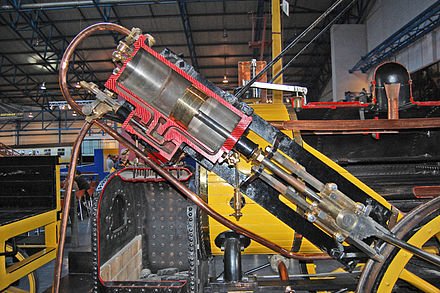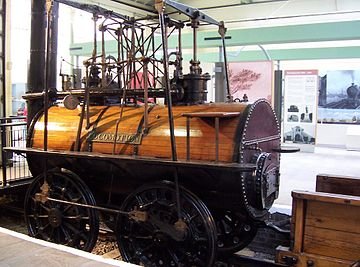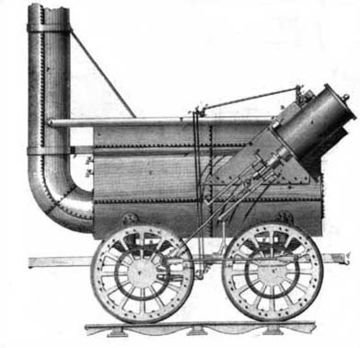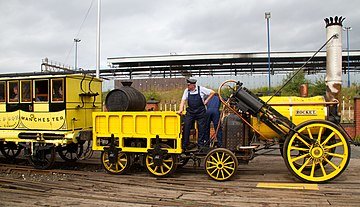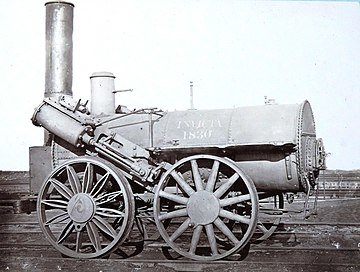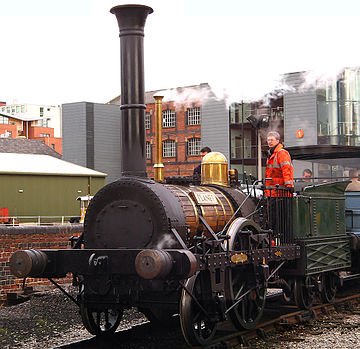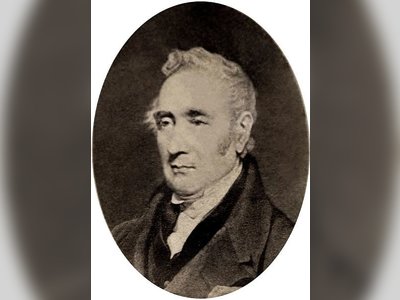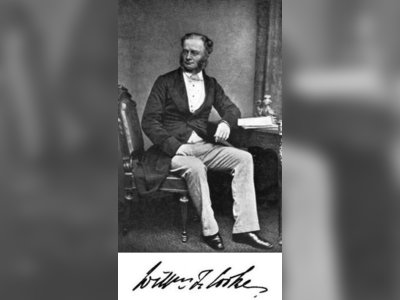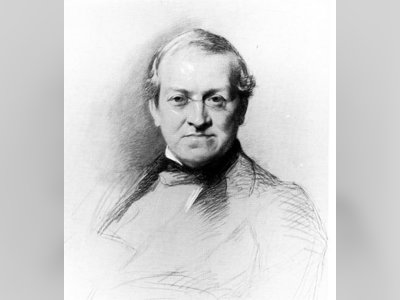British Heritage
Remember, Cherish, Learn.
beta
Stephenson's Rocket - The Railway Train
The Legacy and Contribution to British Heritage.
Stephenson's Rocket, an early steam locomotive of 0-2-2 wheel arrangement, is an iconic symbol of the British Industrial Revolution and its pioneering advancements in railway technology. Designed by Robert Stephenson in 1829, the Rocket's historic significance lies in its victory at the Rainhill Trials held on the Liverpool and Manchester Railway (L&MR). The Rainhill Trials aimed to demonstrate that improved locomotives could outperform stationary steam engines, thus proving the viability of using steam trains for passenger transport.
The Rocket's design brought together various innovative features, making it the most advanced locomotive of its time. Notably, it incorporated a multi-tubular boiler with 25 copper fire-tubes, which significantly increased the surface contact area of hot pipes with the boiler water, leading to improved steaming and boiler efficiency. Additionally, it introduced the use of a blastpipe, which induced a partial vacuum to pull air through the fire, enhancing combustion and reducing fuel consumption.
Stephenson's Rocket secured its place in British history by triumphing in the Rainhill Trials. The locomotive achieved an average speed of 10 miles per hour (16 km/h) over a distance of 70 miles (110 km), surpassing the trial requirement by over 40 percent. Notably, the Rocket demonstrated its hauling power by easily pulling a carriage with over 20 passengers up the Whiston incline at over 15 miles per hour (24 km/h). These impressive performances showcased the potential of steam locomotives for passenger transport, dispelling doubts about their efficiency.
The success of the Rocket at Rainhill had a profound impact on the development of railways in Britain. It bolstered confidence in the use of steam locomotives for public transportation, leading to increased investment in railway infrastructure and the expansion of railway networks across the country. The Rocket's innovative design also served as a blueprint for subsequent steam engines for the next 150 years.
Stephenson's Rocket is undeniably an integral part of British heritage, representing a pivotal moment in the nation's industrial history. As the pioneering locomotive that ushered in the age of the train, the Rocket played a crucial role in transforming transportation in Britain. It marked the beginning of a new era, where steam-powered locomotives would become the backbone of the country's transportation system.
The impact of the Rocket's success extended far beyond engineering and technology. It facilitated the rapid growth of the railway industry, which, in turn, led to economic development, trade expansion, and increased connectivity between cities and regions. The rise of railways contributed significantly to the industrialization of Britain and its emergence as a global economic powerhouse during the 19th century.
After its service on the Liverpool and Manchester Railway, Stephenson's Rocket went through various modifications and experiments. In 1862, it was donated to the Patent Office Museum (now the Science Museum) in London, where it was exhibited for 150 years. In 2018, the locomotive was displayed in Newcastle and Manchester before finding its new home at the National Railway Museum in York.
Multiple replicas of the Rocket were created over the years, further perpetuating its legacy. Notably, a fully functional replica was built for the film "Our Hospitality" in 1923, and additional replicas can be found in the United States at the Henry Ford Museum in Dearborn, Michigan, and the Museum of Science and Industry in Chicago.
The enduring presence of Stephenson's Rocket in museums and historical displays preserves its significance and educates the public about its role in shaping British heritage. The locomotive remains a symbol of innovation, engineering prowess, and the transformative impact of the railways on the nation's history. Today, the Rocket stands as a testament to the ingenuity and vision of George Stephenson and his son Robert, who played key roles in the development of steam locomotion and the British railway system.
The Rocket's design brought together various innovative features, making it the most advanced locomotive of its time. Notably, it incorporated a multi-tubular boiler with 25 copper fire-tubes, which significantly increased the surface contact area of hot pipes with the boiler water, leading to improved steaming and boiler efficiency. Additionally, it introduced the use of a blastpipe, which induced a partial vacuum to pull air through the fire, enhancing combustion and reducing fuel consumption.
Success at the Rainhill Trials and its Impact
Stephenson's Rocket secured its place in British history by triumphing in the Rainhill Trials. The locomotive achieved an average speed of 10 miles per hour (16 km/h) over a distance of 70 miles (110 km), surpassing the trial requirement by over 40 percent. Notably, the Rocket demonstrated its hauling power by easily pulling a carriage with over 20 passengers up the Whiston incline at over 15 miles per hour (24 km/h). These impressive performances showcased the potential of steam locomotives for passenger transport, dispelling doubts about their efficiency.
The success of the Rocket at Rainhill had a profound impact on the development of railways in Britain. It bolstered confidence in the use of steam locomotives for public transportation, leading to increased investment in railway infrastructure and the expansion of railway networks across the country. The Rocket's innovative design also served as a blueprint for subsequent steam engines for the next 150 years.
Contribution to British Heritage
Stephenson's Rocket is undeniably an integral part of British heritage, representing a pivotal moment in the nation's industrial history. As the pioneering locomotive that ushered in the age of the train, the Rocket played a crucial role in transforming transportation in Britain. It marked the beginning of a new era, where steam-powered locomotives would become the backbone of the country's transportation system.
The impact of the Rocket's success extended far beyond engineering and technology. It facilitated the rapid growth of the railway industry, which, in turn, led to economic development, trade expansion, and increased connectivity between cities and regions. The rise of railways contributed significantly to the industrialization of Britain and its emergence as a global economic powerhouse during the 19th century.
Preservation and Legacy
After its service on the Liverpool and Manchester Railway, Stephenson's Rocket went through various modifications and experiments. In 1862, it was donated to the Patent Office Museum (now the Science Museum) in London, where it was exhibited for 150 years. In 2018, the locomotive was displayed in Newcastle and Manchester before finding its new home at the National Railway Museum in York.
Multiple replicas of the Rocket were created over the years, further perpetuating its legacy. Notably, a fully functional replica was built for the film "Our Hospitality" in 1923, and additional replicas can be found in the United States at the Henry Ford Museum in Dearborn, Michigan, and the Museum of Science and Industry in Chicago.
The enduring presence of Stephenson's Rocket in museums and historical displays preserves its significance and educates the public about its role in shaping British heritage. The locomotive remains a symbol of innovation, engineering prowess, and the transformative impact of the railways on the nation's history. Today, the Rocket stands as a testament to the ingenuity and vision of George Stephenson and his son Robert, who played key roles in the development of steam locomotion and the British railway system.
- Stephenson's Rocketen.wikipedia.org


